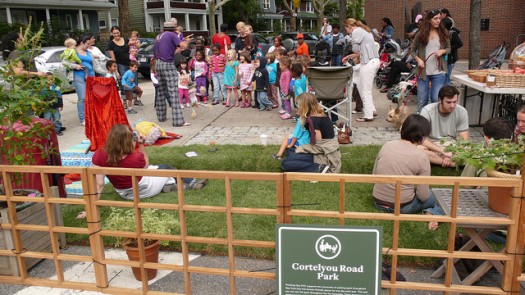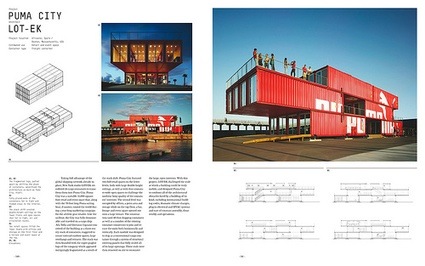
We are celebrating 15 years — and counting — of stories that are deeply researched and deeply felt, that build a historical record of what the city has been.
We are celebrating 15 years — and counting — of stories that are deeply researched and deeply felt, that build a historical record of what the city has been.
This weekend, the design competition Sukkah City will bring twelve modern-day sukkahs to Union Square for two days. The sukkah is a temporary structure constructed during the week-long Jewish festival of Sukkot, meant to commemorate the structures erected by Israelites during their exile from Egypt. Sukkah City asked twelve teams of designers (including 2010 Architectural League Prize recipients Bittertang), selected by jury, to re-imagine this traditional dwelling, conforming to requirements both traditional (“At night, one must be able to see the stars from within the sukkah, through the roof.”) and contemporary (any building with an area larger than 18″ x 9″ is not considered temporary by the Department of Buildings). Following their two-day appearance, you can vote for your favorite on New York Magazine’s website and even bid on them, proceeds to benefit Housing Works.
A fast-moving storm swept through New York last night, causing damage throughout Queens, Brooklyn, and Staten Island. Meterologists clocked winds as high as 109 miles-per-hour and a possible tornado was spotted. In the wake of the storm, passer-bys could be seen snapping photos of the damage, some of which the New York Times documented on their website. To report damage and possibly qualify for disaster relief services, contact the Office of Emergency Management.

Park(ing) Day 2010, photo by Flickr user Sustainable Flatbush
As Streetsblog declares, the many downed trees in the wake of last night’s storm provide the perfect kickoff for Park(ing) Day today, which includes an installation on street tree care entitled “Alternative Side Mulching in Effect Today!” It’s just one of the many events, detailed on this handy map, being held today in celebration of alternative ways to use the city’s coveted street parking spaces. From a BYOB potluck under the BQE, to yoga in Greenpoint, to queer performance art on the street in the East Village, there are plenty of ways you can re-appropriate a parking spot for more creative uses than parking.
In more developments in auto-alternative news, it’s been just over a year since the Bicycle Access Bill directed commercial parking facilities to “provide spaces for bikes at a specific ratio relative to spaces for cars” by December of this year. Streetsblog reports on how one large chain of garages is making the economics of bike parking work (which just happens to be a pretty good deal for cyclists).

A view inside the book “Container Atlas: A Practical Guide to Container Architecture.” Publisher: Gesalten
Over on We Make Money Not Art, Regine reviews a book about another kind of storage structure. If you think architectural experiments with shipping containers are soooo 2005, think again. Even (or perhaps especially) without an economy that fuels the outsize public art ambitions of artists like Gregory Colbert and Shigeru Ban (go here to see Ban’s lecture at the Architectural League from January 2008), there are other architectural applications for the shipping container, and some of them are even practical. And by practical, we mean that this book goes beyond pretty pictures to document plans, describe costs, and suggest solutions for common problems.
But let’s not forget that shipping containers’ original intended function still determines the design and management of global flows of commodities and products as well as the spatial form of the port cities (like Tianjin) that harbor them. Greg Smith and Jordan Hale describe the influence of ubiquitous computing (a topic whose relevance to architecture and urbanism we began to explore with the artists and designers of the League’s Sentient City exhibition and forthcoming book) on the global shipping trade, invoking the system as an example of the emerging internet of things.
For the last ten years, New York City has been dropping its retired subway cars, stripped of contaminants and cleaned, into the Atlantic Ocean, where they serve as marine habitats up and down the East Coast. So far, NYC has contributed over 2,500 cars to the National Artificial Reef Plan. Photographer and self-proclaimed train fanatic Stephen Mallon followed the subway-toting barges out to sea to capture the process from above water as part of his continuing series “American Reclamation,” which examines recycling processes in the US. Check out “Next Stop Atlantic” at Brooklyn’s Front Room Gallery through October 3, and in the meantime listen to WNYC’s Richard Hake talk to Mallon about his work on The Takeaway.
The results from the 2010 census are… maybe New Yorkers are not quite as hard to count after all. Or are they? The full data of this year’s census won’t be released until December, but released findings of the intial mail response show that New York’s participation grew from 57% in 2000 to 60% this year, while the national average remained unchanged at 72%. So while New York remains lagging in this number, the incremental improvement comes after the vast improvements made in the 2000 census, after some 400,000 New Yorkers went allegedly uncounted in 1990. Despite the improvements, the most ethnically diverse neighborhoods continued to have the lowest participation numbers, and are where the canvasing and imputation data will be crucial in determining the accuracy of New York’s count. Meanwhile, new census data out yesterday reported that the national poverty rate grew to 14.3%, and an even greater 15.85 in New York State.
Urban agriculture? There’s an app for that. Over at The Next American City you can find details about the latest web-based ways to get or grow your own urban agriculture. From a new online marketplace enabling buyers and growers of local food to connect, to a website that will tell you where the potatoes that turned into your bag of chips were grown, information for data-hungry local foodies is increasing sprouting all over the web.
The Roundup keeps you up to date with topics we’ve featured and other things we think are worth knowing about.
The views expressed here are those of the authors only and do not reflect the position of The Architectural League of New York.